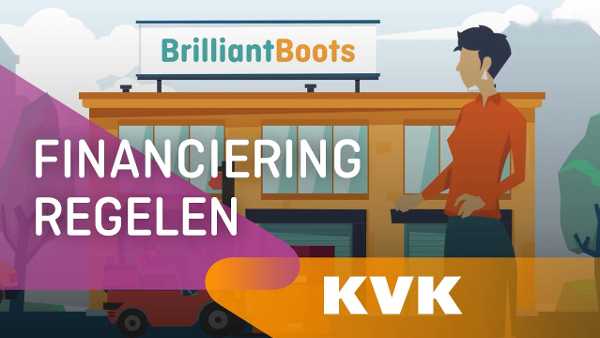Securing financing for working capital

- Alicia Heeger
- Background
- Edited 5 January 2023
- 4 min
- Managing and growing
- Finance
Borrowing money for day-to-day operations is one of the most frequently mentioned reasons for financing. Many entrepreneurs need money to invest in assets and real estate, for refinancing, and for growth and acquisitions. There are several ways to finance working capital.
What is working capital?
Working capital is the money a company needs to meet its daily financial obligations. For example, paying suppliers, paying salaries, maintenance, and restocking. Formally speaking, working capital is the difference between current assets (such as stock, accounts receivable, and cash) and current liabilities (such as accounts payable and other debts).
What is not working capital?
Investments in business assets such as inventory, cars, computers, or machinery are not working capital. Nor is funding for product development or innovation.
Financing from your own business funds
But how can you get your hands on sufficient working capital? The good news is that external financing need not be your first port of call. You can try to free up financial resources within your own business first. Consider being more to alert inventory management. Be proactive when managing money you are due. And consider how you manage money you owe. Furthermore, you can explore tax schemes and save costs.
ACM hotline
Are you an SME or a self-employed professional working for large companies? Large businesses must pay invoices within the agreed payment period. If not, you can report this anonymously to the temporary Overdue Payments Hotline set up by the Dutch Authority for Consumers & Markets (ACM). With this hotline, the government wants to gain insight into how often big businesses fail to honour payment terms in their agreements with SMEs.
Working capital through external financing
There are various different forms of finance you can use to finance working capital. Never forget the golden rule: finance short-term investments with short-term liabilities and long-term investments with long-term liabilities. Financing should always match your intended investment, and the term of the financing should match the relatively short period in which you will use the investment and need the working capital. For long-term investments in assets (buildings, machinery) with a much longer lifespan, for example, it is better to opt for a longer-term form of finance.
Bank
Overdrafts are a well-known type of bank loan that allow you to be ‘in the red’ up to a certain amount. You only pay interest on the money you actually borrow, which can vary depending on your needs.
Crowdfunding
Crowdfunding involves using a platform to raise funds from "the crowd”: people who are willing to invest in your business. Crowdfunding typically starts at investments from €25,000.
Factoring
In factoring and debtor financing, a bank or factoring company supplies you with a particular form of credit or advances most of an invoice amount. Some factoring companies will even pay you an advance on invoices as low as €100. Factoring is for B2B transactions, not for consumer invoices. More and more factoring companies are offering their services to self-employed professionals in addition to SMEs.
Vendor credit
You can agree payment terms with vendors, such as an extended payment period or a discount if you pay quickly.
POS terminal advance and online payment advance
Entrepreneurs that use POS terminals, such as retailers and hospitality businesses, can take out a POS terminal advance to effectively get an advance on their expected turnover. Every day for anywhere between 3 to 6 months they pay a percentage of their turnover to the lender to pay off the loan. POS terminal advances start at approximately €2,000 and go up to €50,000. Similar financing is available for online retailers.
Online credit through fintech lenders
Fintech is short for financial technology and fintech lenders harness online technology to organise the financing process. They offer temporary working capital finance starting at approximately €5,000 right up to €250,000 or even €1 million.
Qredits Flexible Credit
This is a flexible line of credit of up to €25,000. Also consider other Qredits credit, such as microcredit, SME credit or mortgage credit.
Leasing
Leasing is a way to finance operating assets, not working capital. As a result, however, you may free up working capital to keep in your business and avoid having to borrow a large amount to pay for a car, computer, or machine. You pay in monthly instalments spread over a longer period of time.
Assistance for self-employed professionals
If you have financial problems, you can apply for income support and/or credit through the Social Assistance (Self-Employed Professionals) Decree (BBZ). The BBZ provides a credit of €45,670 for entrepreneurs who have been operating for up to a year and a half. The Bbz offers a credit of €45,670 for entrepreneurs who have been active for up to 1.5 years. Longer established entrepreneurs can apply for a maximum of €248,064. Research first whether your situation fits the conditions.
Other forms of finance
Other forms of finance often finance more than just working capital. These can finance other investments as well. In that case, only a part of the total amount of finance is for working capital, such as with business angels, credit unions, private debt funds, and SME grants. If you are interested in these types of finance, check out our overview of alternative forms of financing.
Tips and warning
Working on a funding application? Here are some tips:
- Make sure your records are current so a lender can quickly assess your application.
- Convert the interest rate to an annual rate and determine whether it is acceptable. The MKB Financiering Foundation recommends that total costs including interest should not exceed 20% per year. The Foundation has a quality mark for affiliated lenders (in Dutch) and finance advisers (in Dutch).
- Compare offers from 3 lenders to make a considered choice.
- Read the fine print of the credit proposal. In making your choice, look out for a comprehensible contract, a quality mark and affiliation with an industry association. Lenders with a quality mark or who are members of an industry association have to follow a code of conduct that requires them to act transparently and clearly during the lending process.
Increase your chances
Use the finance flowchart to determine which form of finance is right for you and find a suitable lender. Take a close look at your lender’s criteria before submitting an application. If you find that your score for a particular criterion is sub-par, adjust your operations or explore alternatives in advance.
Get help
Do you have a question about financing or other money issues? Contact a KVK adviser.


